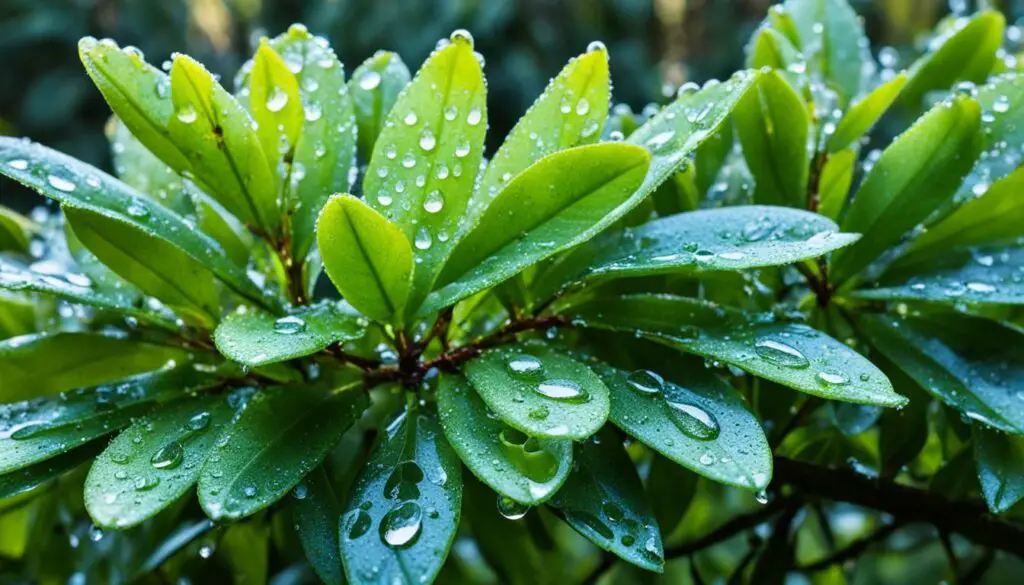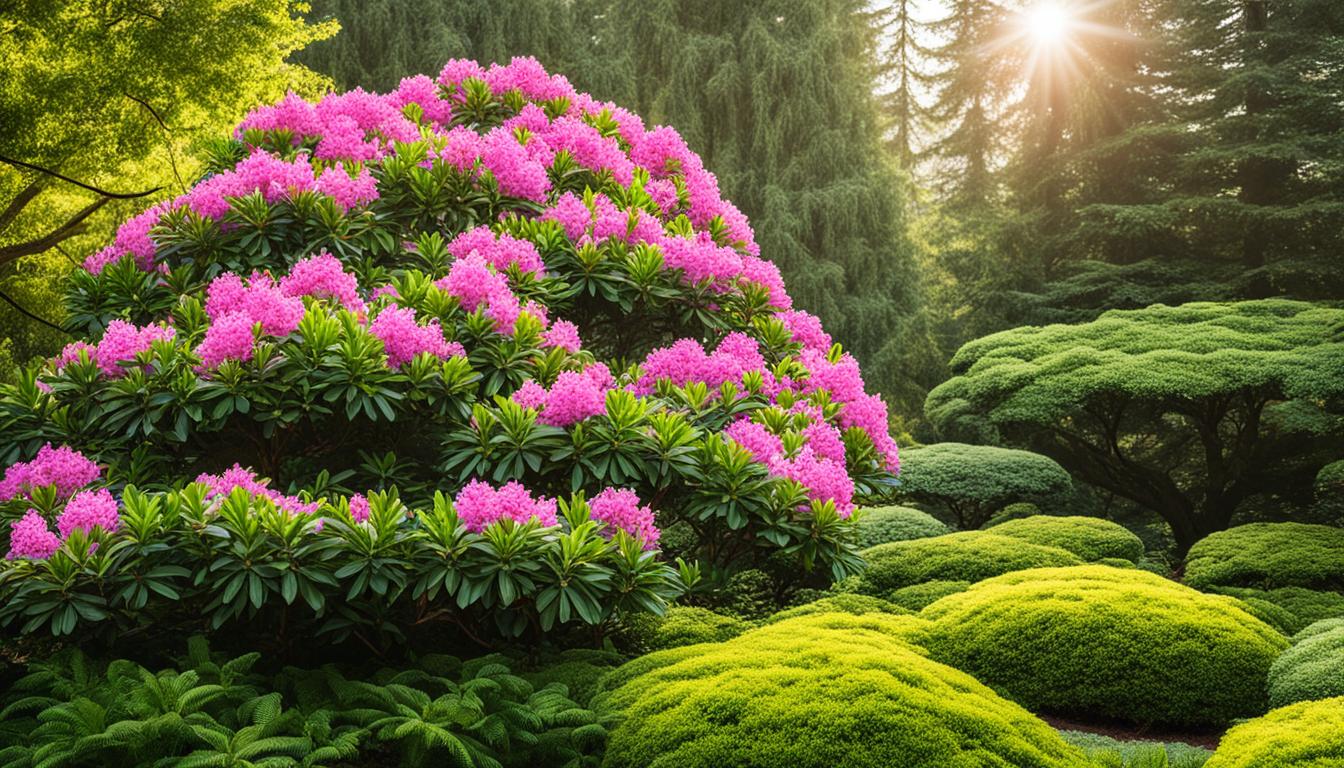Welcome to our comprehensive guide on Rhododendron Arboreum, a stunning flowering shrub that is sure to enhance the beauty of any garden or landscape. Native to the Himalayan region of Asia, this remarkable plant is known for its vibrant red blooms and evergreen foliage. Whether you’re a gardening enthusiast or a botany lover, this guide will provide you with valuable information on how to care for and cultivate Rhododendron Arboreum to ensure its health and vitality.
Key Takeaways:
- Learn how to care for and cultivate Rhododendron Arboreum, a beautiful flowering shrub.
- Discover the optimal watering practices and seasonal strategies to promote healthy growth.
- Understand the importance of proper pruning for the health and aesthetics of your shrub.
- Explore the sunlight and soil requirements for vibrant Rhododendron Arboreum.
- Appreciate the aesthetic value of red Rhododendron in ornamental gardens and botanical exhibits.
Introduction to Rhododendron Arboreum, the Himalayan Wonder

Rhododendron arboreum, commonly known as the Tree Rhododendron, is a magnificent plant species native to the Himalayan region. It belongs to the Ericaceae family and is renowned for its stunning red flowers and glossy evergreen leaves. This section will provide an overview of the plant’s characteristics, natural habitat, and its significance in horticulture and botany.
The rhododendron arboreum, also known as the Himalayan Wonder, is native to the majestic Himalayan mountains. This region is known for its extreme weather conditions, including harsh winters and monsoon rains, making it an ideal habitat for this resilient plant. The Tree Rhododendron is well-adapted to the challenging Himalayan environment, thriving in its cool, high-altitude climate.
The vibrant red flowers of the rhododendron arboreum are a sight to behold. They bloom in late winter to early spring, creating a stunning display against the backdrop of the snow-covered peaks. The flowers are bell-shaped and form in clusters, adding a burst of color to the Himalayan landscape.
In addition to its striking blooms, the rhododendron arboreum also features glossy evergreen leaves. These leaves provide year-round interest and create a lush backdrop for the vibrant flowers. The leaves are leathery and elongated, with a deep green color that serves as an excellent contrast to the red blooms.
In the world of horticulture and botany, the rhododendron arboreum holds significant importance. It is not only valued for its beauty but also for its contribution to research and conservation efforts. The Tree Rhododendron is extensively studied and cultivated in botanical gardens and research institutes around the world. Its genetic diversity and unique adaptations make it a subject of great interest for scientists and horticulturists alike.
Furthermore, the rhododendron arboreum has deep cultural and symbolic significance in the Himalayan region. It is considered a sacred plant in many Himalayan cultures and is associated with various religious and cultural ceremonies. The vibrant red flowers are believed to bring good luck and are often used in traditional rituals and celebrations.
Optimal Watering Practices for the Tree Rhododendron

Proper watering is crucial for maintaining the health and vitality of your Tree Rhododendron. Understanding your plant’s hydration needs is essential to ensure optimal growth and longevity. Here, we will explore the best watering practices for your Tree Rhododendron, including the frequency and volume of watering required.
Understanding Your Plant’s Hydration Needs
The Tree Rhododendron has specific hydration needs that must be met for it to thrive. The frequency of watering depends on various factors, such as the climate, soil moisture, and plant size. Generally, it is recommended to water the Tree Rhododendron deeply and regularly, allowing the roots to absorb moisture effectively.
Monitoring the moisture level of the soil is essential to determine when to water. Stick your finger into the soil up to the second knuckle – if it feels dry, it’s time to water. However, if it feels moist, it is best to wait before watering again.
It is important to note that the Tree Rhododendron prefers moist, well-draining soil. Avoid waterlogging or excessive moisture retention, as this can lead to root rot and other water-related issues.
Rectifying Overwatering and Underwatering Issues
Overwatering and underwatering are common watering problems that can adversely affect your Tree Rhododendron. Overwatering can lead to root rot, oxygen deprivation, and nutrient deficiencies, while underwatering can cause wilting, leaf yellowing, and stunted growth.
If you suspect overwatering, check the soil moisture and ensure proper drainage. If the soil feels consistently wet and the plant shows signs of wilting or root rot, you must rectify the situation immediately. Adjust the watering schedule, allowing the soil to dry out between waterings, and improve the drainage by adding organic matter or amending the soil composition.
Conversely, if your Tree Rhododendron is underwatered, increase the frequency of watering and closely monitor the moisture level. Mulching around the base of the plant can help retain moisture and prevent rapid evaporation during hot, dry periods.
Seasonal Watering Strategies to Enhance Plant Growth
Seasonal changes significantly impact the watering needs of the Tree Rhododendron. As the temperature and humidity fluctuate throughout the year, adjusting your watering practices accordingly is crucial to promote healthy plant growth.
During the active growing season, typically spring and summer, the Tree Rhododendron requires more frequent watering due to increased water needs and higher evaporation rates. It is important to monitor the soil moisture and ensure consistent hydration, especially during hot and dry periods.
In contrast, during the dormant period in fall and winter, the Tree Rhododendron requires less watering. Reduce the frequency of watering, allowing the soil to dry out slightly between waterings. However, it is important to ensure the plant does not completely dry out during this period.
Adjusting the watering frequency and volume according to the seasonal changes will help ensure the Tree Rhododendron receives adequate hydration throughout the year, supporting healthy plant growth and vibrant blooms.
Pruning Your Rhododendron Arboreum for Health and Aesthetics
Pruning is an essential practice to maintain the health and aesthetics of your Rhododendron Arboreum. Proper pruning promotes improved airflow, sunlight penetration, and pest control, ensuring the overall well-being of your shrub.
When pruning your Rhododendron Arboreum, it’s important to follow the correct timing, techniques, and tools for successful results. Here is a step-by-step guide to help you prune your shrub:
- Carefully inspect your Rhododendron Arboreum to identify any dead, damaged, or diseased branches. Use clean and sharp pruning shears to remove these unwanted parts.
- Trim any crossing or rubbing branches to prevent further damage and ensure proper growth and structure.
- Remove any weak or overcrowded branches to encourage stronger growth and allow adequate airflow and sunlight to reach the inner parts of the shrub.
- Consider the desired shape and size of your Rhododendron Arboreum. Trim the outer branches to achieve the desired aesthetic appearance.
- Avoid pruning more than one-third of the shrub’s foliage at a time to prevent stress and ensure healthy regrowth.
Remember to always clean your pruning tools with a disinfectant solution before and after each use to prevent the spread of diseases. By following these pruning guidelines, you can promote the health, vitality, and visual appeal of your Rhododendron Arboreum.
Leveraging Sunlight and Soil for Healthy Rhododendrons
Adequate sunlight is crucial for the growth and flowering of Tree Rhododendrons. These vibrant shrubs thrive in bright, indirect sunlight that mimics their natural habitat. The light requirements for Tree Rhododendrons include:
Light Requirements for Vibrant Tree Rhododendrons
- Exposure: Plant your Rhododendron Arboreum in an area that receives morning sun and afternoon shade. This balance of light will provide the best conditions for healthy growth and abundant blooms.
- Duration: Aim for at least six hours of sunlight per day to ensure optimal photosynthesis and energy production in the plant.
- Intensity: Moderate to high light intensity is preferred, but take precautions to prevent scorching or sunburn on the foliage. Use shade cloth or natural shade from nearby trees to filter intense sunlight.
To leverage sunlight effectively, consider the specific light requirements of your Tree Rhododendron and create a suitable environment that balances exposure, duration, and intensity.
Soil composition plays a crucial role in the health and development of Rhododendron Arboreum. The ideal soil mix should provide the necessary nutrients, pH levels, and drainage for optimal growth. Important considerations for choosing the right soil mix include:
Choosing the Right Soil Mix
| Soil Characteristics | Ideal Conditions |
|---|---|
| Acidity | Slightly acidic soil with a pH range of 4.5 to 6.0. |
| Drainage | Well-draining soil that prevents waterlogging, as excessive moisture can lead to root rot. |
| Organic Content | Rich, organic matter that promotes soil fertility and moisture retention without compaction. |
When planting or transplanting your Tree Rhododendron, ensure the soil mix meets these ideal conditions. You can amend the soil with organic matter, such as compost or peat moss, to improve its structure and nutritional composition.
By leveraging sunlight and choosing the right soil mix, you can create an optimal environment for your Rhododendron Arboreum to thrive and showcase its vibrant blooms.
The Alluring Aesthetics of Rhododendron Arboreum
Rhododendron species, including Rhododendron Arboreum, are beloved for their captivating beauty and are often showcased in botanical gardens. These gardens worldwide display the marvelous diversity of Rhododendron species, highlighting their various colors, shapes, and sizes.
Botanical gardens play a significant role in conservation efforts by preserving and exhibiting these flowering plants. They serve as educational resources for plant enthusiasts, offering opportunities to learn about different species, their habitats, and cultivation techniques.
Rhododendron Species: Marvels of Flowering Plants in Botanical Gardens
In botanical gardens, visitors can marvel at the stunning array of Rhododendron species. These gardens showcase the unique characteristics and aesthetic appeal of various rhododendron cultivars, adding a touch of natural beauty to the surroundings.
Rhododendrons come in a wide range of colors, including vibrant reds, pinks, oranges, purples, and whites. They exhibit different flower shapes, from trumpet-shaped blooms to frilly petals, attracting the attention of visitors with their striking appearance.
These botanical gardens provide an ideal setting to appreciate the intricate beauty and botanical diversity of rhododendron species. Visitors can immerse themselves in the vibrant colors and delicate fragrances, gaining a deeper appreciation for these captivating flowering plants.
The Decorative Value of Red Rhododendron in Ornamental Gardens
In ornamental gardens, red Rhododendron cultivars hold significant decorative value. Their striking and vibrant flowers make them stunning additions to garden design. Red rhododendrons can be used as focal points, drawing attention and adding a bold splash of color to the landscape.
They are also suitable for creating borders and hedges, complementing other plants and providing a visually pleasing contrast. Red rhododendrons can be incorporated into existing garden layouts, creating captivating combinations with other flowering plants.
In both botanical gardens and ornamental gardens, red rhododendrons enhance the visual appeal and bring a touch of elegance to the surroundings. Their vibrant blooms and lush foliage create a captivating atmosphere, making them highly sought after by gardeners and plant enthusiasts.
| Rhododendron Species | Botanical Gardens | Ornamental Gardens |
|---|---|---|
| Various colors, shapes, and sizes | Display the marvelous diversity | Add decorative value |
| Preserved and exhibited for conservation | Role in conservation efforts | Striking focal points |
| Opportunities for learning and education | Educational resources for plant enthusiasts | Borders and mass plantings |
Conclusion
In conclusion, the Rhododendron Arboreum is an extraordinary flowering shrub that brings beauty and charm to gardens and botanical collections. By following the care guidelines outlined in this guide, you can ensure the health and success of your Tree Rhododendron, allowing it to thrive and showcase its vibrant blooms for years to come.
Remember to pay attention to the watering practices, pruning techniques, sunlight and soil requirements, and the aesthetic value of this captivating shrub. Maintaining a proper watering schedule and providing adequate sunlight and suitable soil conditions will contribute to the overall health and vitality of your Rhododendron Arboreum.
Whether you’re a gardening enthusiast or a professional landscaper, the Rhododendron Arboreum offers an excellent choice for enhancing the visual appeal of your outdoor space. Its stunning red flowers and glossy evergreen leaves will create a vibrant and captivating display, attracting the attention of all who see it.
So, roll up your sleeves and get ready to cultivate your own little piece of Himalayan wonder. Happy gardening!
